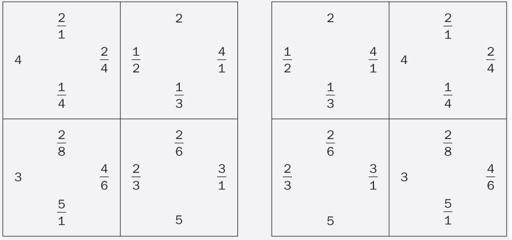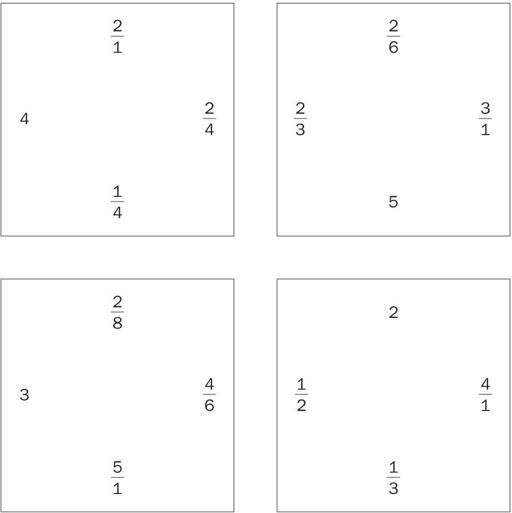Teaching the Common Core Math Standards With Hands-On Activities, Grades 3-5 (14 page)
Read Teaching the Common Core Math Standards With Hands-On Activities, Grades 3-5 Online
Authors: Judith A. Muschla,Gary Robert Muschla,Erin Muschla-Berry
Tags: #Education, #Teaching Methods & Materials, #Mathematics, #General

BOOK: Teaching the Common Core Math Standards With Hands-On Activities, Grades 3-5
13.09Mb size Format: txt, pdf, ePub
Materials
Scissors; reproducible, “Four Squares,” for each pair or group of students.
Procedure
1.
Review equivalent fractions and whole numbers expressed as fractions. For example,
2.
Hand out copies of the reproducible and explain that students will see four squares, each of which contains fractions and a whole number.
3.
Instruct your students to cut out each square.
4.
Explain that they should arrange the squares so that the sides that have equivalent fractions are next to each other. Note that the numbers on the squares may not be turned upside down. Remind students that whole numbers may be written as fractions.
Closure
Discuss the positions of the squares with your students.
Answers
Two possible arrangements are shown below.
Activity 2: Balancing Fractions
Working at a Web site, students will virtually drag fraction bars to a scale to determine their relative size.
Materials
Computers with Internet access for students; computer and digital projector for the teacher.
Procedure
1.
Instruct your students to go to
http://mathplayground.com/Scale_Fractions.html
. Explain that they will use a virtual balance scale to compare fractions.
2.
Demonstrate how to compare fractions using the virtual balance. For example, dragto the left side of the scale and
to the right. The “
” is displayed on the scale because
Next, click “Reset.” Drag five
pieces to the left side of the scale and seven
pieces to the right side to show that
3.
Instruct your students to drag other fractions to the scale and write at least five comparisons. They should record their comparisons so that they can share their results with the class at the conclusion of the activity.
Closure
Discuss the comparisons that students made. Discuss any patterns students noticed. For example, they should notice that when the denominators are the same, the larger numerator represents the larger fraction.
Four Squares
Measurement and Data: 3.MD.1
“Solve problems involving measurement and estimation of intervals of time, liquid volumes, and masses of objects.”
1. “Tell and write time to the nearest minute and measure time intervals in minutes. Solve word problems involving addition and subtraction of time intervals in minutes, e.g., by representing the problem on a number line diagram.”
Background
Telling time is an essential skill. By looking at a circular clock students can tell what time it is, what time it will be later, or what time it was a few moments ago. For example, if it is 2:15, students may count by fives to find the time in 20 minutes—2:20, 2:25, 2:30, 2:35.
Other books
Snowbound in Montana by C. J. Carmichael
Farm Girl by Karen Jones Gowen
My Life as a Mankiewicz by Tom Mankiewicz
Zel: Markovic MMA by Roxie Rivera
Take Me Down (Suits in Pursuit) by Lauren H. Kelley
Eyes of Darkness by Dean Koontz
A Glimmering Girl by L. K. Rigel
In the Hand of the Goddess by Tamora Pierce
Dirty Magic by Jaye Wells
The Wealth of Kings by Sam Ferguson




